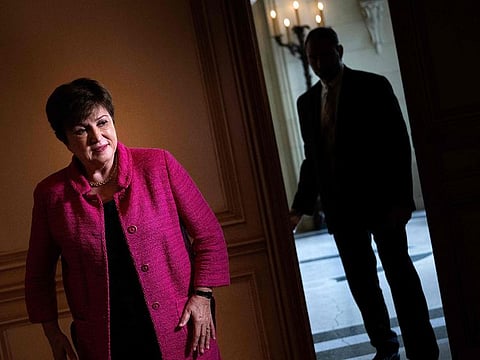IMF trims world growth outlook as financial risks raise pressure
Gross domestic product will likely expand 2.8% this year and 3% next year

The International Monetary Fund trimmed its global-growth projections, warning of high uncertainty and risks as financial-sector stress adds to pressures emanating from tighter monetary policy and Russia’s war against Ukraine.
Gross domestic product will likely expand 2.8 per cent this year and 3 per cent next year, each 0.1 percentage point less than forecast in January, the fund said on Tuesday in a quarterly update to its World Economic Outlook. That compares with 3.4 per cent expansion in 2022.
The unexpected failures last month of Silicon Valley Bank and Signature Bank and the collapse of Credit Suisse Group AG roiled markets and ignited financial-stability concerns, complicating central banks’ quest to tame inflation while maintaining growth and the health of the banking system.
“The risks are weighted heavily to the downside, in large part because of the financial turmoil of the last month and a half,” said Pierre-Olivier Gourinchas, the fund’s chief economist. “That is under control as of now, but we are concerned that this could result in a sharper and a more elevated downturn if financial conditions were to worsen significantly.”
While the reduction in the 2023 forecast isn’t large, the report showed the IMF is more subdued about the outlook than in January, when it saw this year as a “turning point” for the global economy and risks were more balanced.
Last week, the IMF warned growth over the next five years will be limited. That’s based on risks from economic fragmentation caused by geopolitical tension - including the escalating US-China rivalry that’s reinforced by the war in Europe - as well as slower labor-force growth and decelerating long-term rates of expansion in China and South Korea.
While the IMF has lowered its estimate for global growth, the World Bank raised its outlook to 2 per cent from 1.7 per cent in January, owing to stronger Chinese expansion, President David Malpass said Monday.
The fund sees the global inflation rate at 7 per cent this year, 0.4 percentage point higher than the January projection, though down from 8.7 per cent in 2022. The slowdown stems from declining commodity prices and the impact of interest-rate increases. For most countries, the pace of price growth will remain above central bank objectives until 2025.
Inflation rates are expected to be lower in about 76 per cent of countries in 2023 than in 2022 and to slow further to 4.9 per cent in 2024.
While the financial turmoil looks controlled as of now, the IMF is concerned about the potential impact if conditions worsen significantly, Gourinchas told reporters.
Adverse scenarios
In one scenario, which it calls a “plausible alternative”, financial instability remains contained but impacts conditions more than in the IMF’s base case and banks reduce lending. That would cause growth to slow to 2.5 per cent in 2023, the weakest pace since 2001, excluding the first year of the Covid-19 pandemic in 2020 and the global financial crisis of 2009.
In a severe downside scenario, which has about a 25 per cent probability, there could be significant credit disruption, and the pace of global expansion could slow to less than 2 per cent - something that’s only happened five times since 1970. There’s also about a 15 per cent probability of growth at just 1 per cent.
Additional risks beyond the financial sector include inflation taking longer than expected to slow, China’s reopening faltering, or a worsening of the Russia-Ukraine war.
“We’re seeing a lot of downside risk going forward,” Gourinchas said.
Sign up for the Daily Briefing
Get the latest news and updates straight to your inbox



